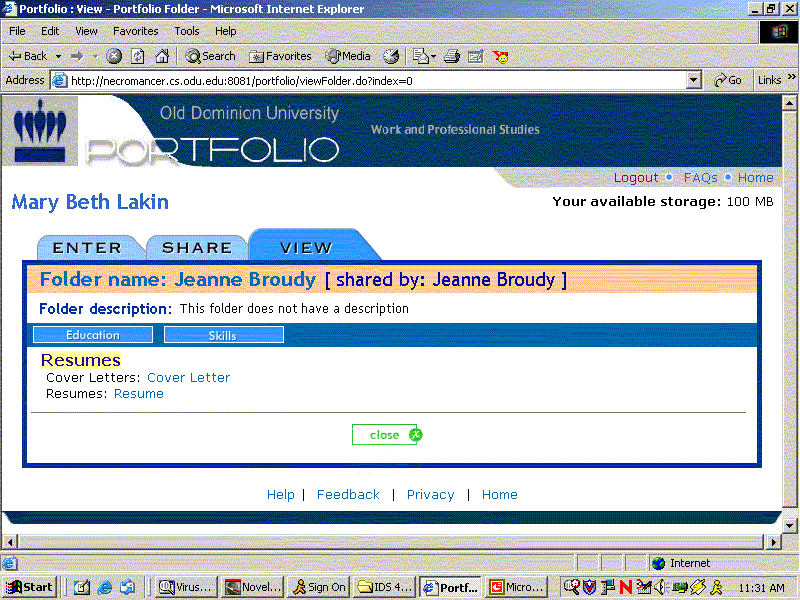Video Conferencing, Blackboard and Eportfolios
Delivery of the Work and Professional Studies curriculum relies on a variety of media including: video conferencing, Blackboard and the WPS Eportfolio System. In addition, students in the core sequence frequently communicate with the WPS director via email or phone. The video conferencing component of the program occurs in the virtual classrooms of Old Dominion University’s TELETECHNET program. These are interactive television studio classrooms located in Norfolk, Sterling (in Northern Virginia), Portsmouth, Newport News, and Virginia Beach. Over the course of three semesters, students met at least five times a semester in these virtual classrooms. These sessions extended the work that students had already accomplished in Blackboard and the Work and Professional Studies Electronic Portfolio system. These sessions also serve as a real-time, almost residential component of the program because they bring students together and provide a sort of social glue that helps the students bond in ways not possible via asynchronous discussion board and email exchanges alone. Having a variety of technologies available as learning environments creates productive redundancy in the lines of communication. If students do not learn well in one environment, they are presented with alternative learning situations.
Two of the communication technologies we used are mature systems: the interactive television classroom studios and Blackboard (See Figure 1 above). “Mature” here means that the systems are officially supported by the university and have been in use for a number of years. The one new learning technology we have used is our adaptation of the Open Source Portfolio software, the WPS Eportfolio
Based on OSP 1.0, WPS Eports was installed on a server hosted in the computer science department in August 2003 (see Figure 1). Basic modifications were made to the software during August and September, and we planned to have the system go live for students on September 19th, 2003. However, Hurricane Isabel struck the Hampton Roads area on September 18th, delaying the launch until October. The WPS Eports system ran effectively throughout the remainder of the fall semester; there were three server crashes but no data was lost. The downtime was frustrating to students, especially since many of them worked on their eportfolios over the weekends and the crashes tended to happen on Fridays. Server downtime never exceeded 24 hours. Student frustration was not high at this point, since we had explained that the WPS Eports was a developmental projection throughout the 2001-2002 academic year as well as during fall 2003; we also gave students systematic opportunities for providing feedback on the technology and support.

Fig. 1. A screenshot of the WPS Eports system.
Based on student feedback, we planned on making modifications to the WPS Eports software during January and February of 2004. These changes included:
- Increasing disk space to include student’s reflective video “essays”;
- Reducing the number of clicks required to perform basic functions;
- Creating an option to share eportfolios among groups of users rather than individually; and
- Redesigning the presentation look and feel (under the VIEW menu ideally by moving towards a template model with student customization possible).
Although these changes were to be tested on version of the software and not the live eportfolio project, the main database table was overwritten on the live version of the software. In addition to the database manager replacing the table with an empty table, the taped backups made by the system administers were not functioning. In short, by February 27 th, 2004, we were left with the task of repopulating the database and trying to recreate the links and relationships among student files rather than redesign the application.
Students had made backups of their files, but reloading these into WPS Eports proved difficult. In effect, it was easy to upload the files, but the relationships among files were impossible to reestablish.
While the students and instructor continued to work during March and April, much of their work with the content of the eportfolios moved from WPS Eports into Blackboard. For instance, instead of using the Comment feature within WPS Eports as tool for revision, students used Group Pages within Blackboard. The redundancy in lines of communication and learning environments proved especially useful here.
During March and April, the students continued to develop as a community of learners; with a range of experiences and expertise, they were in the final stages of reflecting on their own work and that of others. Blackboard was used for posting work in progress, providing feedback to classmates, and collaborating on ideas for the development and use of the eportfolio in work and learning environments. Students operated as experts, resources, facilitators, mentors, audiences, and reviewers. By late March, the WPS Eports system was operating again and students began to upload the final versions of their work samples. Students also gave three-minute presentations in the videoconference setting; these were put in digital video format as another supporting document for their eportfolios.
The students’ final presentation portfolios were created from the documents and commentary that they had created within WPS Eports. Ultimately, WPS Eports became much more of a storage and staging ground for the electronic portfolios rather than a place where either drafting or presentations of the portfolios actually occurred. As we will explain in the conclusion, our experiences working with electronic portfolios and three different learning environments suggest that when students invest time and effort into electronic portfolios, they want to “own” them. In our case, students conveyed that they owned the processes of developing their electronic portfolios but not the end products.
Working (on) Electronic Portfolios
Connecting
Academic Work and
the Workplace